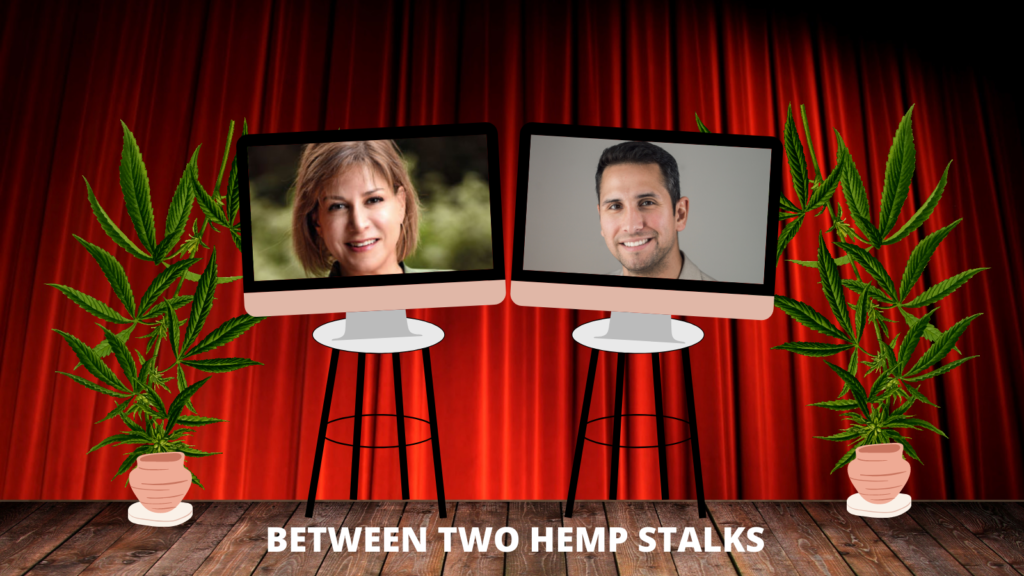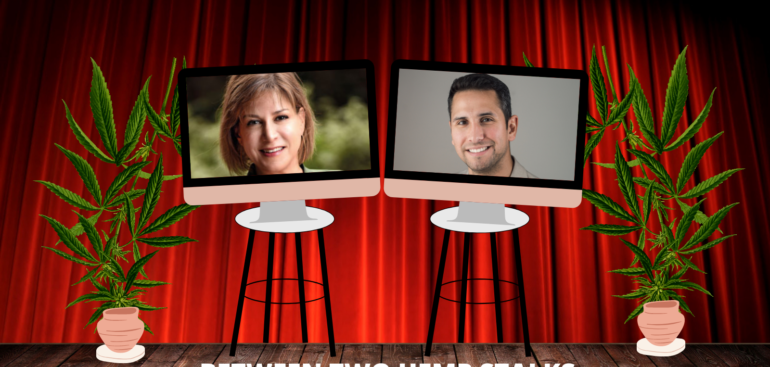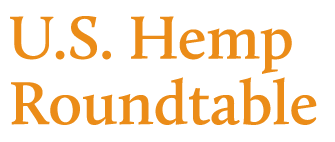Latest
Between Two Hemp Stalks
PanXchange Blog
The following is a transcript of a conversation between PanXchange’s CEO, Julie Lerner, and Moharram Ventures Founder & President, Tarek Moharram, on Lerner’s latest (and possibly one-time) show, “Between Two Hemp Stalks.”

Lerner: Often, during industrial hemp harvests, many farmers share with PanXchange their frustration of wasting hemp hurd, so I’m glad to be here with you today Tarek to discuss precisely that. I was intrigued when the Supercritical team introduced me to Truly Green Plastic™ (TGP). For those who have not heard about your company, can you explain what it is?
Moharram: Of course, Julie – thanks for having me. I built Moharram Ventures as a sort of idea factory – where teams of accomplished inventors, visionaries, Masters-/PhD-prepared scientists, technologists, and other creators could collaborate to build the future. One of our projects resulted in TGP development, the world’s first fully-biodegradable polymer sourced entirely from cannabis plant waste. By leveraging our internationally-claimed intellectual property, we are now building several relationships with potential investors, public sector decision-makers, and private sector partners. We can scale our science up to commercial capacity and begin satisfying the growing consumer demand for our novel material.
Lerner: So, I’m a former sugar trader. What you are describing is what we’d call “bagasse.” It’s what’s left after everything else has been extracted from the cane stalk. Is this the same thing, but with the hemp stalk?
Moharram: Yes, we’re solving one waste problem with another. On the one hand, our planet is – quite literally – drowning in fossil fuel plastic. It’s scattered across our streets, stacked layer upon layer in our landfills, and floating about in our oceans. It has become so pervasive that it has now entered our food stream in the form of microplastics. On the other hand, a significant amount of waste is created in the existing cannabis cultivation process. In the adult-use and medical markets, it’s eight kilos of waste for every kilo of dried flower produced. Staggering, especially when you factor in that many times, other chemicals are added to the pile before shipped off to landfills. Even in the industrial hemp space, given the glut of biomass on the market right now, plant components perceived to have a lower commercial value are simply being left to rot. In creating TGP, we instead utilize this biomass as a carbon source to create sustainable plastic pellets that can be manufactured into various products.
Lerner: I’m sure you’ve received this question plenty as a start-up company, but how is TGP different from others?
Moharram: There are various competitive advantages, which separates us from the field. Naturally, the top of the list is global IP protection. Next, many other polymer producers who use biomass from this space use the (untreated or partially-treated) plant material as a filler ingredient. These plastics, therefore, have to rely on mixing the filler biomass with other ingredients; the better options using things like cornstarch, the worse ones using the same sorts of fossil fuel plastics that we’re trying to replace. Finally, plant-based bioplastics using other feedstocks are often using a material with several other valuable applications (such as foodstuffs). TGP solves all of these problems – the glucose from the biomass is used to create a separate material (our entirely biodegradable plastic pellets). It does need to be (but can be) mixed with other ingredients, and it uses a waste material that is of low value to producers. TGP also has unique mechanical properties, making it easier to process than other comparable polymers – such as noticeably lower melting temperature and a slightly higher destruction temperature.
Lerner: Here at PanXchange(™), we define hemp hurd as derived from the hemp plant’s main stalk. After removing the long fibers, the resulting product is a wood-like, cellulose-rich substance composed of short fibers. Does your team prefer hemp hurd coming from the CBD market or prefer hemp hurd coming from the grain and fiber markets? Is this distinction important to you all?
Moharram: When we started with this project, we understood that additional steps to process the biomass would create higher costs and endanger maintaining sensible margins. That’s why we conducted our testing on the stalk biomass itself. No decortication is needed. Once the root balls have been removed and desired flower and seed products have been harvested, we can take the rest and use it for our process. All that we require is milling and grinding – not for segregation, but just to increase the amount of surface area and allow for more accessible transportation. We can even take the biomass after extraction processes have been applied to it for harvesting CBD and the plant’s other unique elements.
Lerner: In what stage of growth is TGP?
Moharram: We are working hard to scale our science from producing laboratory quantities to commercial capacity. We have won several pitch competitions, we were asked to present to the American Chemical Society, and have received significant media attention. We have executed several Letters of Intent with upstream and downstream parties interested in our technology. We are now raising capital to construct a processing facility to meet growing customer demand. TGP has a unique position on the value chain that grants us the ability to connect with once disparate businesses across different industries. Our relationships include biomass producers, biomass haulers, biomass processors, plastics manufacturers, and end-user/consumer brands during this process. Additionally, our team explores opportunities to partner with notable public sector players to promote more sustainable agriculture in this space and further enhance a circular economy’s momentum in the global plastics marketplace.
Lerner: It might be too early to ask, but if this could be an additional revenue source for our hemp-growing clientele, we’d love to hear more. Do you have a high-level estimate of how much farmers could increase their per-acre profitability by selling to TGP?
Moharram: There will be a substantial opportunity for farmers to profit from partnering with us. We are in talks right now with several biomass producers, each of whom has a significant geographic footprint. The conversation we’ve been having with one of them circled the following observation. If the farm is already earning close to what they would get out of growing canola from just hemp seed, what happens when the flower, stalk, and extract points on the value chain have been optimized? In terms of making TGP out of the fibrous stalk material, the resulting polymers would have a margin of about USD 2/kilo. As this emerging biopolymers market continues to mature, we expect that this profit potential will continue to blossom.
Lerner: Are there ESG benefits in selling the hurd waste?
Moharram: Without question. One of the most significant gaps in the cannabis space right now, and I’m sure this is also true concerning hemp production, is the brands’ failure to communicate effectively with consumers on their values. Successful brands are based upon authenticity and connecting with the market on more than just price, quality, and quantity. People care about organizations that care about something. Consumers in this market are particularly conscious about sustainability and industrial impact upon the environment. Going to the market and saying, ‘Hey, we give a damn about what we’re doing to the planet, and it’s not just empty talk – here’s what we’re doing about it,’ that differentiates an organization from being one of many players in the space and, instead, establishes that party as the leader within the space.
Lerner: Yes, I’ve seen many companies re-evaluate their ESG investments over the last year with all the changes 2020 has brought onto different markets and customer sentiments. Which industry do you believe will be the first to adopt this technology on a mass scale?
Moharram: Plastic manufacturers and consumer packaged goods brands will likely be our first set of early-adopters, but I expect that more folks will soon be jumping on board as we further demonstrate the legitimacy of our technology.
Lerner: So, what exactly sparked the idea of TGP?
Moharram: Nearly three years ago, I was giving some thought to creating a pet services line. As part of the process, I realized how over-engineered dog waste bags were – they could do far more things than they needed to, and, as a result, they wouldn’t biodegrade properly without specialized facilities. I decided to develop a polymer that would be better suited for single-use or short-term use applications, and one that wasn’t too expensive for average consumers to afford. I recruited a team of experts, and it quickly became apparent that identifying a low-cost feedstock would be an essential part of the process. When I learned about the staggering amount of waste involved in cannabis cultivation, my team and I dove deeper. The rest is history.
Lerner: How can we at PanXchange help TGP?
Moharram: Oh, you’re already helping. Right now, our goal is to spread the word about this vital work so that we can bring TGP to the market. The greater public awareness about the environmental damage caused by fossil fuel plastic, the more people understand the value left behind in this agriculture segment. The sooner we can get others to appreciate our polymer’s fascinating high-value applications (such as in pharmaceuticals, nutriceuticals, and cosmetics), the more likely we will find partners that align with our values with whom we can collaborate on this journey.
Lerner: Thank you so much for your time. Where can our readers go if they want to reach you for more information regarding TGP?
Moharram: My pleasure – thanks again, Julie, for hosting me. I’d encourage your readers to visit TrulyGreenPlastic.com for more information. We’re also on several of the established social media channels, but the best bet would be to find me on LinkedIn. I’ve even begun speaking at international events on topics related to this project, so I’m generally circulating within the community.









